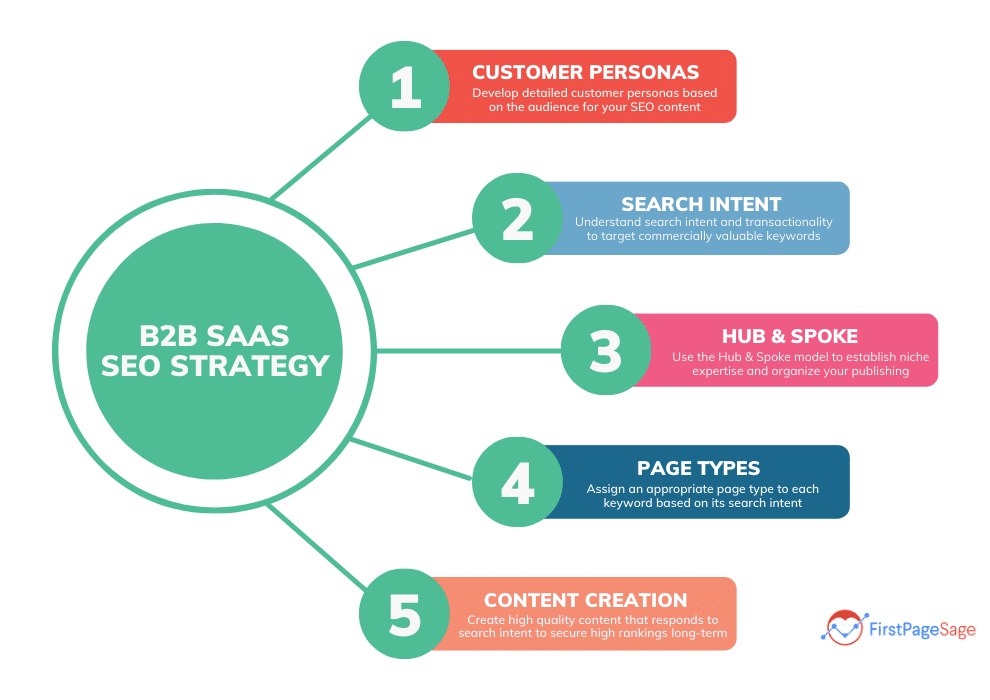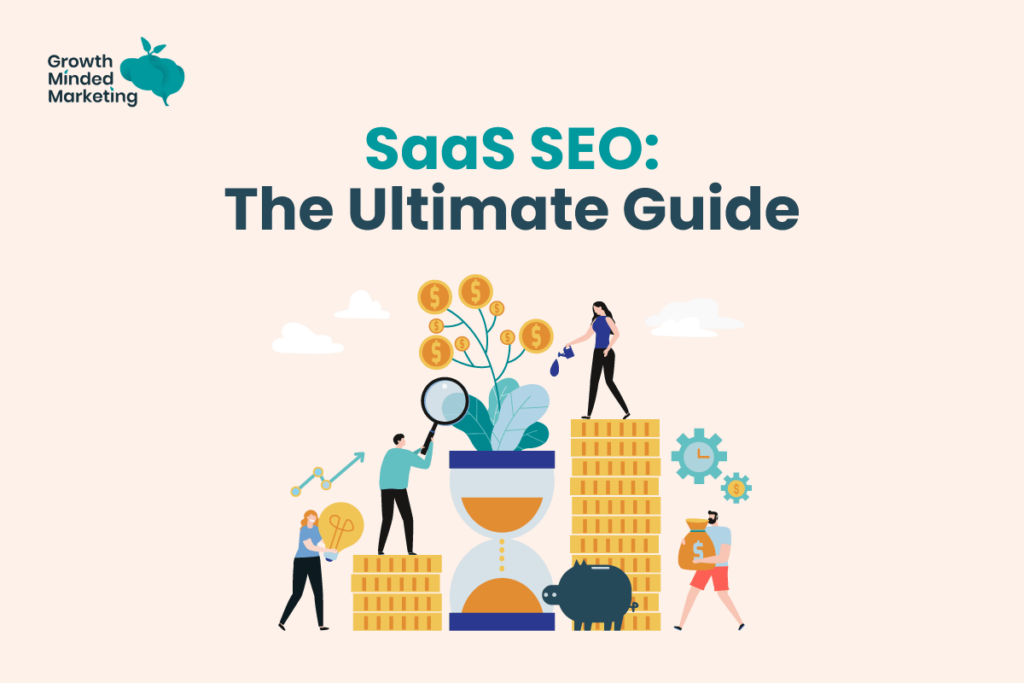Uncover the secrets to skyrocketing your SaaS product’s success with a killer SEO strategy that will drive massive growth.

Image courtesy of via DALL-E 3
Table of Contents
Introduction to SaaS and SEO
In today’s digital world, two key components play a vital role in the success of software products: Software as a Service (SaaS) and Search Engine Optimization (SEO). Understanding what SaaS is and why SEO is crucial for SaaS products can greatly impact the visibility and success of your software.
What is SaaS?
SaaS, short for Software as a Service, is a software delivery model that allows users to access applications over the internet. It eliminates the need for users to install and maintain the software on their own devices, making it convenient and cost-effective. Popular examples of SaaS products include Google Drive, Dropbox, and Salesforce, which offer various services through a subscription-based model.
Why is SEO Important?
Search Engine Optimization (SEO) is the practice of optimizing your website to improve its visibility on search engines like Google. For SaaS products, having a strong SEO strategy is crucial for attracting potential customers who are searching for solutions online. By incorporating SEO best practices, your product can rank higher in search results, making it easier for interested users to find and engage with your software.
Understanding Your Audience
Before crafting an effective SEO strategy for your SaaS product, it’s essential to know who your users are. By understanding your audience, you can tailor your approach to meet their specific needs and preferences. One way to figure out who is using your SaaS product is by conducting surveys and gathering user feedback. These insights can provide valuable information about your users’ demographics, interests, and behaviors.
Researching Customer Needs
In addition to understanding who your users are, it’s crucial to research what your customers are looking for online. By identifying their needs and preferences, you can create targeted content that addresses their specific pain points and offers solutions. Conducting market research and analyzing customer behavior can help you better align your SEO strategy with the needs of your target audience.
Keyword Research Basics
Keyword research is a crucial part of any successful SEO strategy. By understanding what keywords your target audience is searching for, you can create content that ranks higher in search engine results and drives more traffic to your SaaS product. Let’s dive into the basics of keyword research and why it’s so important for your product’s success.

Image courtesy of growthmindedmarketing.com via Google Images
What are Keywords?
Keywords are the words and phrases that people type into search engines when looking for information online. They are like the keys that unlock the door to relevant content. For example, if someone is searching for a project management tool, they may type in keywords like “best project management software” or “top project management tools.”
By using the right keywords in your content, you can make sure that your SaaS product shows up in search results when potential customers are looking for solutions that you provide. Keywords help search engines understand the relevance of your content to users’ queries.
Using Keyword Tools
There are many tools available to help you with keyword research. One popular tool is Google Keyword Planner, which provides insight into the search volume and competition for specific keywords. Another tool is Ubersuggest, which offers keyword suggestions based on a seed keyword you provide.
These tools can help you identify relevant keywords that have high search volume but low competition, giving you a better chance of ranking well in search results. By incorporating these keywords strategically into your website content, blog posts, and other marketing materials, you can attract more organic traffic to your SaaS product.
Mastering keyword research is key to boosting your SaaS product’s visibility online and reaching your target audience effectively.
Creating Quality Content
Creating quality content is essential for your SaaS product to stand out online. There are various types of content you can use to engage with your audience. For example, you can write informative blog posts, create engaging videos, or design eye-catching infographics. Each type of content serves a different purpose and can attract different types of users to your product.
Writing for Your Audience
When creating content for your SaaS product, it’s important to write in a way that resonates with your audience. This means understanding their needs and interests and crafting your content to address those. Use language that is clear and straightforward, avoiding technical jargon that may confuse your readers. Keep your writing style engaging and informative, providing value to your audience with every piece of content you publish.
Optimizing On-Page SEO
In the world of SEO (Search Engine Optimization), on-page SEO plays a crucial role in determining how well your SaaS (Software as a Service) product ranks on search engine results pages. By optimizing your website’s content and structure, you can improve its visibility and attract more potential customers. Let’s delve into some key strategies for optimizing on-page SEO.

Image courtesy of contentatscale.ai via Google Images
Using Headings and Tags
Headings (such as H1, H2) and tags (like meta tags) are essential elements that help search engines understand the structure and relevance of your content. By using descriptive headings and relevant tags, you can make it easier for search engines to crawl and index your website. This, in turn, can improve your site’s chances of ranking higher in search results.
Optimizing URLs and Images
When it comes to on-page SEO, optimizing your URLs and images is key. Create SEO-friendly URLs that are concise, descriptive, and include relevant keywords. This not only helps search engines understand the content of the page but also makes it easier for users to identify what they can expect to find on that page.
Additionally, don’t forget about images. When including images on your website, be sure to use descriptive file names and alt text. Alt text provides a textual description of the image, which is not only helpful for visually impaired users but also gives search engines more context about the image. By optimizing your images with relevant keywords, you can further improve your on-page SEO efforts.
Building Backlinks
In the world of SEO, backlinks play a crucial role in improving the visibility and authority of your SaaS product. But what exactly are backlinks, and how can you acquire high-quality ones to boost your website’s ranking on search engines?
What Are Backlinks?
Backlinks, also known as external links, are links from other websites that point back to your site. Search engines like Google consider backlinks as a vote of confidence in your content, signaling that other reputable sites find your information valuable and trustworthy. The more high-quality backlinks you have, the higher your website is likely to rank in search engine results pages.
Acquiring Quality Backlinks
To acquire quality backlinks for your SaaS product, you need to focus on building relationships with other websites and establishing your credibility in your industry. Here are some effective strategies to get backlinks from reputable sites:
1. Guest Blogging: Write informative and engaging guest posts for relevant websites in your industry. In exchange for your content, you can typically include a link back to your own website in the author bio or within the body of the article.
2. Partnerships: Collaborate with other businesses, industry influencers, or bloggers to create valuable content that includes links back to your site. By forming partnerships, you can expand your reach and attract backlinks from their audiences.
3. Content Marketing: Create high-quality and shareable content, such as infographics, videos, or guides, that other websites will want to link to. Promote your content through social media and email marketing to increase its visibility and chances of earning backlinks.
By implementing these strategies and consistently seeking opportunities to earn backlinks from reputable sources, you can strengthen your SaaS product’s authority and improve its SEO performance over time.
Monitoring and Analyzing SEO Performance
Once you have implemented your SEO strategy for your SaaS product, it is essential to monitor and analyze its performance to ensure that it is effective and yielding results. By tracking key metrics and analyzing the data, you can make informed decisions to improve your SEO strategy further.

Image courtesy of yamumedia.com via Google Images
Using Analytics Tools
One of the most crucial aspects of monitoring your SEO performance is utilizing analytics tools like Google Analytics. These tools provide valuable insights into how users are interacting with your website, the sources of your traffic, and which keywords are driving the most organic traffic to your site.
By analyzing this data, you can identify trends, understand user behavior, and measure the effectiveness of your SEO efforts. This information can help you make adjustments to your strategy and focus on areas that are generating the best results.
Making Improvements
Based on the data gathered from analytics tools, you can make informed decisions about how to improve your SEO strategy. If you notice that certain keywords are not performing well, you can adjust your content to better optimize for those keywords. If you find that a particular type of content is resonating with your audience, you can create more of that content to drive more traffic to your site.
Additionally, monitoring your backlink profile and identifying high-quality backlinks can help you build authority and improve your search engine rankings. By consistently monitoring and analyzing your SEO performance, you can stay ahead of the competition and continue to drive organic traffic to your SaaS product.
Local SEO for SaaS
In the world of Software as a Service (SaaS), it’s not just about having a great product – it’s also about making sure your target audience can find you online. This is where Local SEO (Search Engine Optimization) comes into play, especially for SaaS companies that operate in specific geographical regions.
What is Local SEO?
Local SEO is a strategy that focuses on optimizing your online presence to attract more business from specific local searches. This includes searches with geographic qualifiers, such as “near me” or “in [city name].” For SaaS companies looking to target customers in certain areas, local SEO is essential for increasing visibility and driving relevant traffic to your website.
Optimizing for Local Search
So, how can SaaS companies optimize their websites for local search? Here are a few key strategies to consider:
First, make sure your business’s name, address, and phone number (NAP) are consistent across all online platforms. This includes your website, social media profiles, and online directories. Consistency is key to establishing trust with both users and search engines.
Next, incorporate location-based keywords throughout your website content. This can include mentioning specific cities or regions you serve, as well as using local landmarks or colloquial terms that your target audience may use in their searches.
Furthermore, consider creating location-specific landing pages or content tailored to different geographic areas. This can help you better target potential customers in those regions and improve your chances of appearing in local search results.
Lastly, encourage customer reviews and testimonials on platforms like Google My Business, Yelp, or industry-specific review sites. Positive reviews not only build credibility for your SaaS product but also improve your local search ranking.
Summary of SaaS SEO Strategies
In this article, we have delved into the world of Software as a Service (SaaS) and explored the significance of Search Engine Optimization (SEO) strategies for SaaS products. Let’s recap some of the key strategies and tips discussed:

Image courtesy of growthmindedmarketing.com via Google Images
1. Understand Your Audience: Identifying your target audience and researching their needs is crucial for crafting effective SEO strategies tailored to their preferences.
2. Conduct Keyword Research: Keyword research forms the backbone of any successful SEO strategy. Utilize tools like Google Keyword Planner to identify relevant keywords for your content.
3. Create Quality Content: Engaging and valuable content is essential for attracting and retaining your audience. Experiment with different content types such as blog posts, videos, and infographics.
4. Optimize On-Page SEO: Structure your content with proper headings, tags, URLs, and images to enhance its visibility on search engines.
5. Build Quality Backlinks: Establishing high-quality backlinks from reputable sites can significantly boost your SEO performance. Consider guest blogging and forming partnerships for backlink opportunities.
6. Monitor and Analyze SEO Performance: Regularly track your SEO performance using tools like Google Analytics. Use the data to make informed decisions and improve your strategies.
Conclusion:
By implementing these SEO strategies effectively, SaaS companies can enhance their online visibility, attract more organic traffic, and ultimately boost their product’s success in a competitive digital landscape.
Want to turn these SEO insights into real results? Seorocket is an all-in-one AI SEO solution that uses the power of AI to analyze your competition and craft high-ranking content.
Seorocket offers a suite of powerful tools, including a Keyword Researcher to find the most profitable keywords, an AI Writer to generate unique and Google-friendly content, and an Automatic Publisher to schedule and publish your content directly to your website. Plus, you’ll get real-time performance tracking so you can see exactly what’s working and make adjustments as needed.
Stop just reading about SEO – take action with Seorocket and skyrocket your search rankings today. Sign up for a free trial and see the difference Seorocket can make for your website!
Frequently Asked Questions (FAQs)
Common Queries about SaaS SEO
1. What is SEO and why is it important for SaaS products?
SEO stands for Search Engine Optimization. It’s crucial for SaaS products because it helps them appear higher in search engine results, making it easier for potential customers to find them online.
2. How can I identify who is using my SaaS product?
There are various methods to determine your user base. You can use surveys, feedback forms, website analytics, or even conduct interviews with your current users to understand their needs and preferences.
3. What are keywords, and why are they essential for SEO?
Keywords are specific words or phrases that people use to search for information online. By using relevant keywords in your content, you can help search engines understand what your SaaS product is about and rank it higher in search results.
4. How do I create engaging content for my SaaS product?
To create compelling content, you need to understand your target audience’s needs and preferences. You can use different types of content like blog posts, videos, or infographics to provide value to your users and keep them engaged.
5. What are backlinks, and why are they important for SEO?
Backlinks are links from other websites that direct traffic to your site. They are crucial for SEO because search engines consider backlinks as a vote of confidence in your content, which can help improve your site’s authority and visibility.
6. How can I monitor the performance of my SEO strategy?
You can use tools like Google Analytics to track the performance of your SEO efforts. These tools provide valuable insights into how well your website is performing in search results, helping you make informed decisions to optimize your strategy.
7. Why is local SEO important for SaaS companies?
Local SEO is essential for SaaS companies targeting specific regions because it helps them appear in local search results when users search for products or services in their area. This can help increase visibility and attract more local customers.







